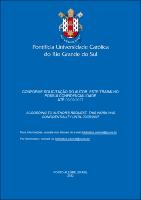| Share record |


|
Please use this identifier to cite or link to this item:
https://tede2.pucrs.br/tede2/handle/tede/10442| Document type: | Tese |
| Title: | Comparação entre técnicas para caracterização extrínseca de cerâmicas em cad/cam |
| Author: | Oliveira, Pâmella Tomazi Godoy de  |
| Advisor: | Teixeira, Eduardo Rolim |
| First advisor-co: | Mota, Eduardo Gonçalves |
| Abstract (native): | Objetivo: O presente estudo visa avaliar a rugosidade e a estabilidade de cor de cerâmicas de dissilicato de lítio e de leucita após ciclagem por escovação. Materiais e Métodos: 84 blocos cerâmicos (1.0 cm x 1.0 cm) foram produzidos em dissilicato de lítio e leucita e divididos em 3 grupos, de acordo com a técnica pós-usinagem utilizada: grupo 1: cerâmica polida (controle negativo) (CN); grupo 2: cerâmica maquiada seguida de glaze, de acordo com as recomendações do fabricante (controle positivo) (CP); grupo 3: maquiagem simultânea ao glaze (técnica alternativa) (TE). A alteração do brilho e da rugosidade superficial foi avaliada em 4 tempos distintos, após o teste de escovação simulada. Resultados: Os resultados dos testes multivariados mostraram que houve efeito de interação tripla entre os fatores material, tratamento e tempo sobre a rugosidade média (p < 0,001) e a luminosidade (valor p < 0,05). Não houve diferença estatisticamente significativa na rugosidade média nos grupos de CN e TE para as amostras de leucita e de dissilicato de lítio, mas houve aumento da rugosidade média em t1 no grupo CP e TE. Em relação aos resultados de luminosidade na comparação dentro dos materiais e tempos houve diferença estatisticamente significativa nas amostras de leucita no grupo CP em relação aos demais. Já os grupos CN e TE não diferiram estatisticamente entre si. Conclusão: Houve igual estabilidade de cor nas amostras de todos os grupos testados nas cerâmicas à base de leucita ao longo do tempo. Nas cerâmicas de dissilicato de lítio houve redução da luminosidade no grupo do polimento. Nas cerâmicas à base de leucita a rugosidade média ocupou posição intermediária na técnica experimental em relação ao grupo do polimento e ao grupo do pigmento e glaze em todos os tempos. Nas cerâmicas à base de dissilicato de lítio, o grupo da técnica experimental apresentou rugosidade semelhante ao pigmento e glaze. Relevância Clínica: A TE apresentou semelhante estabilidade de cor e rugosidade intermediária em relação aos demais grupos e superfície menos rugosa ao longo do tempo após os ciclos de escovação simulada, em relação ao grupo CP. |
| Abstract (english): | Objective: The present study aims to evaluate the roughness and color stability of lithium disilicate and leucite ceramics after brushing cycling. Materials and Methods: 84 ceramic blocks (1.0 cm x 1.0 cm) were produced in lithium disilicate and leucite and divided into 3 groups, according to the post-machining technique used: group 1: polished ceramic (negative control) (NC); group 2: stain (pigmented) ceramic followed by glaze, according to the manufacturer's recommendations (positive control) (PC); group 3: simultaneous staining with glaze (alternative technique) (TE). The change in gloss and surface roughness was evaluated at 4 different times, after the simulated brushing test. Results: The results of the multivariate tests showed that there was a triple interaction effect between the material, treatment and time factors on the average roughness (p< 0.001) and luminosity (p value < 0.05). There was no statistically significant difference in the mean roughness in the NC and TE groups for the leucite and lithium disilicate samples, but there was an increase in the mean roughness at t1 in the CP and TE groups. Regarding the results of luminosity in the comparison within the materials and times, there was a statistically significant difference in the leucite samples in the CP group in relation to the others. The CN and TE groups did not differ statistically from each other. Conclusion: There was equal color stability in samples from all groups tested on leucite-based ceramics over time. In lithium disilicate ceramics, there was a reduction in luminosity in the polishing group. In leucite-based ceramics, the average roughness obtained an intermediate position in the experimental technique in relation to the polishing group and the pigment and glaze group at all times. In lithium disilicate ceramics, the experimental technique group showed similar roughness to the pigment and glaze. Clinical Relevance: TE showed similar color stability and intermediate roughness in relation to the other groups and a less rough surface over time after the simulated brushing cycles, in relation to the CP group. |
| Keywords: | CAD/CAM Dental Ceramics Surface Roughness Colour |
| CNPQ Knowledge Areas: | CIENCIAS DA SAUDE::ODONTOLOGIA |
| Language: | por |
| Country: | Brasil |
| Publisher: | Pontifícia Universidade Católica do Rio Grande do Sul |
| Institution Acronym: | PUCRS |
| Department: | Escola de Ciências Saúde e da Vida |
| Program: | Programa de Pós-Graduação em Odontologia |
| Access type: | Acesso Aberto |
| Fulltext access restriction: | Trabalho será publicado como artigo ou livro |
| Time to release fulltext: | 60 meses |
| Date to release fulltext: | 09/09/2027 |
| URI: | https://tede2.pucrs.br/tede2/handle/tede/10442 |
| Issue Date: | 17-Mar-2022 |
| Appears in Collections: | Programa de Pós-Graduação em Odontologia |
Files in This Item:
| File | Description | Size | Format | |
|---|---|---|---|---|
| TES_PAMELLA_TOMAZI_GODOY_DE_OLIVEIRA_CONFIDENCIAL.pdf | PAMELA_TOMAZI_GODOY_DE_OLIVEIRA_TES | 765.98 kB | Adobe PDF |  Download/Open Preview |
Items in DSpace are protected by copyright, with all rights reserved, unless otherwise indicated.




